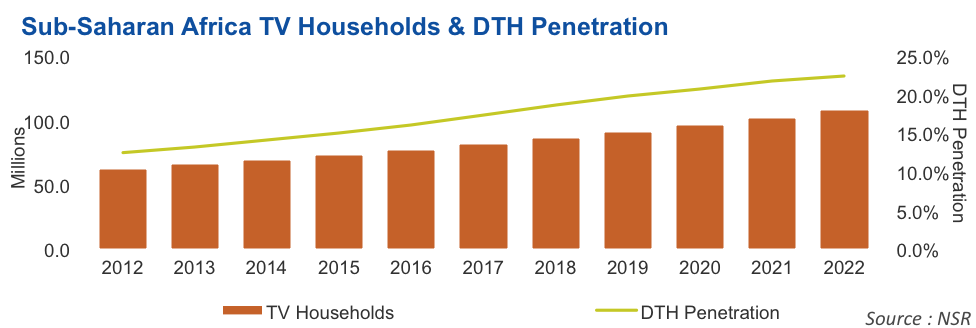The Last DTH
Frontier
Jul 23rd, 2013
by
Blaine Curcio, NSR
Sub-Saharan Africa will
provide tremendous
opportunities for DTH
platforms over the coming
years. These opportunities
will be driven by: 1) very
low TV household penetration
rates currently, 2) economic
development and population
increases, and 3) the
current hole in the market
where a low-cost,
low-margin, almost
“India-esque” operator
should be. For these
reasons, Sub-Saharan Africa
may be primed for a period
of considerable growth in
the DTH industry.
NSR’s most recent DTH
study, Global
Direct-to-Home (DTH)
Markets, 6th
Edition, estimates
Sub-Saharan Africa’s current
regional TV penetration rate
is just under 47%. However,
this does not tell the whole
story; 35 of the 46
countries included in
Sub-Saharan Africa have TV
penetration rates of lower
than 50%, with these
countries’ combined
population exceeding 500
million. Furthermore, there
are over 71 million
households in Sub-Saharan
Africa without a television.
As economic development and
falling TV prices lead to an
increase in TV penetration
throughout the continent,
the addressable market for
DTH operators—namely, homes
with TVs, will increase
dramatically from a
relatively low starting
point. NSR predicts TV
households in SSA will
increase from 63M in 2012 to
108M by 2022, and continue
to increase moving forward.
In addition to growth
through existing households
acquiring their first TV,
Sub-Saharan Africa will also
experience rapid population
growth. Between now and
2022, Sub-Saharan Africa’s
population is projected to
increase by roughly 200
million people, to around
1.1 billion. Further,
looking long-term, the
region is expected to be
home to 1.5 billion people,
or an increase of 600
million from today, by 2035.
This continued explosion in
population is particularly
noteworthy when considering
other developing countries
(Indonesia, Bangladesh, and
to a lesser extent India, to
name a few) are experiencing
declining birth rates—and
thus declining population
growth.

However, no matter how
many people or TV households
come to be in Sub-Saharan
Africa, there is still an
absence of one crucial
thing—consumers with the
disposable income to support
DTH platforms, and platforms
that cater to those
consumers’ needs. This is
where there has been an
inherent disconnect in
recent years. For example,
comparing Nigeria, SSA’s
largest country with over
170 million people, to
India, one notices that
their per capita income is
nearly equal, with Nigeria’s
being 4% higher than India’s
(~$1,650 compared to $1,600
per year, according to the
IMF). However, the
lowest-cost DTH package in
Nigeria costs over $6.20US
per month, whereas the
lowest-cost packages in
India cost less than $3.
Therefore, average Nigerians
are being asked to spend
nearly 5% of their monthly
income on DTH services,
whereas in India the number
is less than 2.5%. With
several Indian operators
recently turning a profit,
and showing that the
“high-volume, low-ARPU”
business model can be a
viable one, there is every
reason to believe this can
be achieved in Sub-Saharan
Africa.
In summation, all the
ingredients are present in
Sub-Saharan Africa for a DTH
boom—currently low TV
penetration rates that are
increasing rapidly, a large
and fast-growing population,
and a general trend of
foreign investment and
economic development. To
cater to this rapidly
emerging market, a truly
low-cost operator is needed,
along the lines of those
currently present in India.
Bottom Line
While Sub-Saharan Africa
remains largely undeveloped,
there is a perfect storm
brewing that will spell
immense opportunities for
DTH platforms, provided they
attack the correct market
segments. While the upper
and middle classes are
already relatively
well-served by operators,
the continent lacks a
serious offering for the
lower-class, which will make
up the bulk of population
and addressable market
growth moving forward.